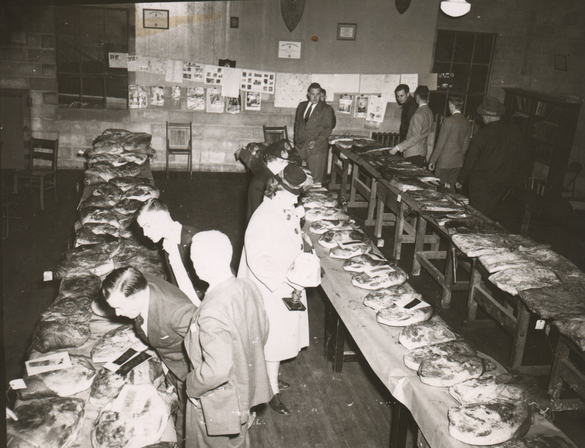
| Next Chapter | Previous Chapter | |
| Chapter 18: The Model 8N Ford-Ferguson Tractor | Contents | Chapter 16: Doyle Kittle |
The Future Farmers of America was a very important part of my education. It was an extra curricular activity conducted within the Vocational Agriculture classes. By the time we got to graduation, our class was down to 26 kids. Vo-Ag was given each of the four years of high school, and almost all of the boys took it. It received unusual emphasis at both Unidis High School at West Milford and at Lost Creek High School. When I arrived at high school both of these schools were considered top vocational agriculture high schools in the United States.
(Illustration 17-1)

Annual Ham, Bacon and Egg Show in the Unidis FFA building. - Thanks to Jim Stuttler for all the pictures in this chapter.
There is an annual contest among FFA chapters in which they are evaluated on various factors, the best ones being rated "National Gold Emblem Chapters." Both Unidis and Lost Creek won the honor four times. E. F. Bond, my uncle, who taught at Lost Creek, and Luther Hutton at Unidis were the teachers when this happened. Obviously, Southern Harrison County is not great farming country. Many people even then were what the census calls "rural, non-farm." This area is mostly residential now. Then (in the 1950's) people worked in mines and strip mines, and factories in Clarksburg, mostly glass factories, and operated the small businesses that provided the essential support for the population such as small stores, gas stations, and professional services.
(Illustration 17-2)
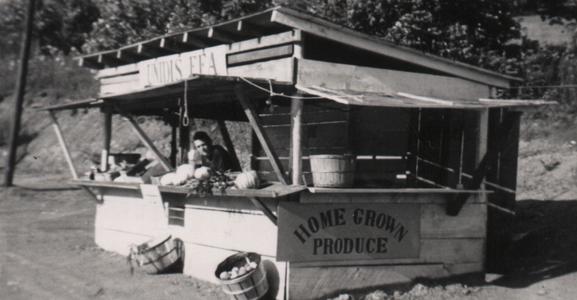
Bob Kennedy sells fruit and vegetables at the FFA produce stand
In Hutton's time activities were paramount. They had a butcher plant set up, so that eight to ten hogs could be butchered on school grounds in a day. The first class would go out and kill, bleed and transport the hogs to the high school. The next class would begin the butchering and by the end of the day the hogs would be reduced to hams, bacon and sausage. These would be smoked and judged and even sold by the FFA Chapter if the owner wished. There was an Annual Ham, Bacon and Eggs Show with auction.
The FFA had a Christmas tree farm and sold trees at Christmas. They bought formaldehyde in fifty-five gallon barrels and used it to treat seed potatoes, and sold some to individuals in gallon jugs. The treated seed was sold along with fertilizer to anyone interested. Treated seed potatoes weren't available on the market at the time.
They raised an acre of popcorn and sold popcorn to the Robinson Grand and Ritz theaters in Clarksburg in bulk, shelling the corn by hand. They bought Burpees garden seeds in 100 pound bags and sold them in smaller quantities. Delivery was sometimes made in a black 1934 Ford pickup owned by the Chapter.
(Illustration 17-3)
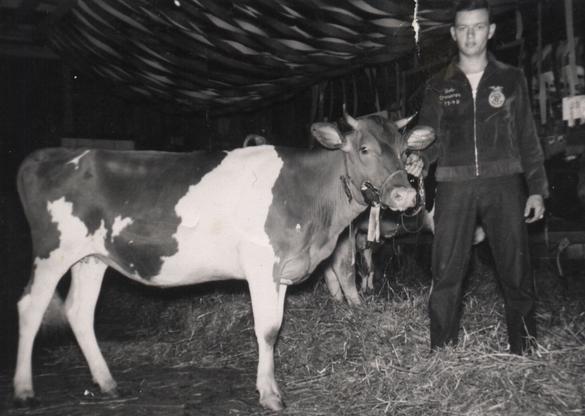
Bob Steele and his dairy heifer at the Jackson's Mill Dairy Show
One year the Unidis Chapter had 48 dairy heifers in the Annual Dairy Show at Jackson's Mill. Many of the FFA students at this time went into farming or agribusness
Bond and Hutton "played the game" very well. They were very popular with both students and the school organization. They knew how to get people to do things. They knew how to accumulate points. Hence they sponsored two of the most outstanding FFA chapters in the nation. The Board of Education was sufficiently impressed to build separate, dedicated, Vocational Agriculture buildings at the two high schools. These involved large concrete block buildings, with a classroom twice the size of any other in the school, and a shop twice the size of that, with an office for the teacher, tool storage and rest room. Rest room is singular, notice. This was before the day of young women in Vo-Ag.
(Illustration 17-4)
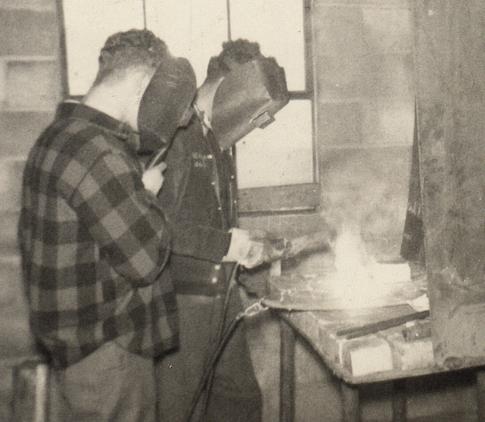
Students welding in the new Vo-Ag building
Some other ambitious county hired Hutton away after my eighth grade. Momentum was such that the last National Gold Emblem was won the year after he left. In later years the chapter won a National Bronze Emblem (four each of gold, silver and bronze are awarded each year). Hutton never got another National Gold Emblem, but he was a good teacher. His approach toward getting achievement from students is characterized by the motto he quoted from the entry of the church he attended as a boy: "The road to Hell is paved with good intentions." You did what was needed in his classes.
(Illustration 17-5)
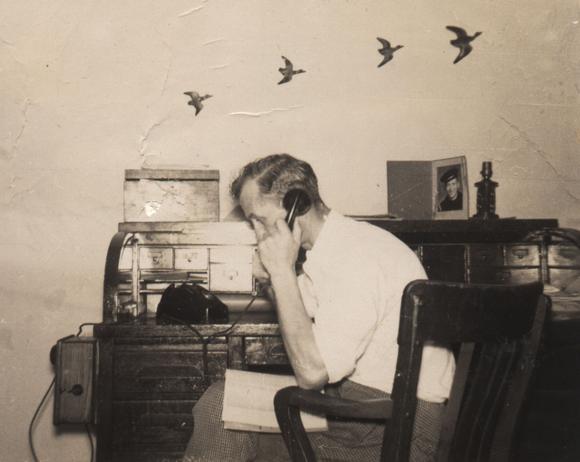
H. G. Riddle at his desk in the new Vo-Ag building
My teacher for the high school years was Glen Riddle. Riddle was a very intelligent man, also energetic and well liked. Unidis consistently won high status in the state, but never made National Gold Emblem honors again.
Unfortunately the author is not as familiar with the Lost Creek FFA Chapter activities. However, Bond did something that was very much admired at the time. National Geographic was doing an article on FFA. Since Lost Creek was prominent, they came there for part of it. They wanted the Lost Creek FFA chapter to have a "Hoe Down," a hillbilly dance with picturesque clothes, mountain music, etc. He sent National Geographic on its way. This was not the real world of the Lost Creek, and this was not the image any of us wanted to project. It could have helped sell National Geographic, but it would have helped give West Virginia an undignified image, and we were very sensitive about that.
Farming requires all kinds of skills and our Vo-Ag classes had a more than a smattering of many of these. We had to keep records for our projects, and we learned how to keep records, "interest on investment," and all. I think today that if farmers considered interest on their investment, most of them would be doing something else. But it was an expense we charged to our projects.
We drew diagrams and constructed things of wood and metal from our diagrams. We learned about various crops and animals. We used all kinds of tools, brought machinery to school to repair and paint in the shop. We learned a little about electricity (this was shortly after the "rural electrification" program that lighted the countryside and encouraged the use of motors to do farm work).
Leadership skills were considered important. We had annual public speaking contests and one could go all the way to the "National." We learned Robert's Rules of Order, practiced them, had a very good parliamentary procedure team, and entered competitions. To this day it disgusts me to go into a meeting where the presiding officer doesn't know parliamentary procedure, or to hear people depreciate following some rules of order (there are other good systems, besides Robert's Rules of Order). This attitude has to do with ignorance of any procedural rules for meetings, something not taught in public schools, and also with personal sloppiness.
One of the most popular activities was smoking hams, mentioned above in connection with butchering. There was a small concrete block house just above the gym. It had been built especially to smoke hams. It had a concrete floor, ideal for smoking hams. The shavings were prepared in the shop, and poles put across the top of the building to hang hams on. Members of the FFA chapter and others brought in their hams. The Ham, Bacon and Egg Show continued for many years.
(Illustraton 17-6)
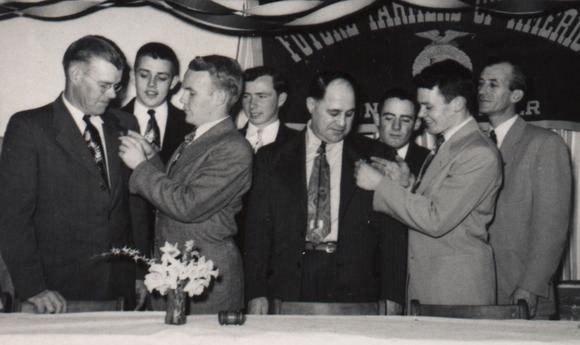
Induction of FFA Honorary members. Front row: Paul V. Bond, the author's father, the author, Mr. Yates, Gail's father, Joe Kennedy, President. Back row: Gilbert Sumners, Jack Boyers, Gail Yates and Glenn Riddle.
The smoking process is traditional. Before the turn of the century all farms had a cellar dug into the earth with a smokehouse above the cellar, which also served as a larder or storage place for the smoked meat. (See Illustration 20-2 below.) Smoking is done more as a flavoring than as a preservative, but I imagine that the smokehouse atmosphere would have discouraged insects in the old days. A few boys would be chosen to stay each night and attended the fire. They would be allowed to stay at school all night, when no one else was around. They would sleep part of the time in the Vo-Ag building, but would mostly talk all night. Getting to do this was a strong incentive to help with other Vo-Ag programs.
We also served as auxiliary volunteer fire fighters. On occasion the Volunteer Fire Department in West Milford could not respond to fire calls. Then they would let us go out with the fire truck to fight the fire. I think we would yell all the way! It was fulfillment of a small boys dream, given to older boys: to ride on the fire truck and go to the fire. Sometimes high school students have the emotions of much younger kids, you know, and it got us out of school. One of the boys would drive the truck. Can you imagine the liability worry that arrangement would cause today! Kids riding loose on the truck, a kid driving, and kids without permission from home fighting fire!
I think the leadership training - parliamentary procedure, speech contests, and especially meeting people from other schools and cooperating and competing with them served us very well. In those days we did not have much contact with people from other schools, because transportation was not available, and we were more separated by distance because of that. A lot of us have turned out well, and have gotten good use of those skills which were not honed in any other school activities. Athletics is good for in-group leadership, but it is all competition with students from other schools, and does not lead to development of the social and verbal skills that are necessary in the big world beyond your neighborhood. Almost all interschool activities pit the students from one school against all others in competition (some, very little short of cultivating hatred), rather than training them to adjust and cooperate.
Aside This story dates from the late nineteen-thirties or early -forties. Sam Sheets was a prosperous farmer who lived across the valley from our farm on Lost Creek. "The University,"(West Virginia University) was just beginning to turn out people trained in agriculture who had never lived or worked on a farm. Some of these programs required the student to gain a year's experience on a farm before beginning to practice what they had learned in their courses. Sam employed some of these young men to work on his farm.
One year he took in a young man from Clarksburg who was learning to be a Vocational Agriculture teacher. The young man arrived one morning and Sam told him to go to the barn and harness one of the fine Belgian horses he owned and bring it around to the front door of the house. He was gone a much longer time than was required for the task, so Sam decided to go to the barn and see what the delay was all about. When he got there, the fellow was trying to put the horse's collar on upside down, and just couldn't seem to manage it!
Luther Hutton went on to become the prize winning Vo-Ag teacher in Chapter 17 on FFA above. Most of the farm is now owned by Jim Stutler, who told me this story, and South Harrison High School stands on some of that old farm along the Lost Creek-West Milford road.
| Next Chapter | Previous Chapter | |
| Chapter 18: The Model 8N Ford-Ferguson Tractor | Contents | Chapter 16: Doyle Kittle |
Copyright © 1998, 2006, 2008, 2011 S. Tom Bond (stombond at hughes.net)